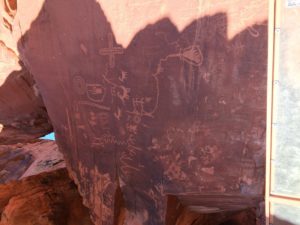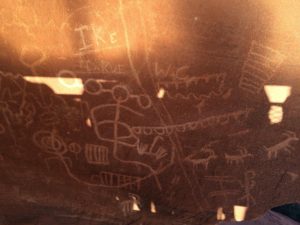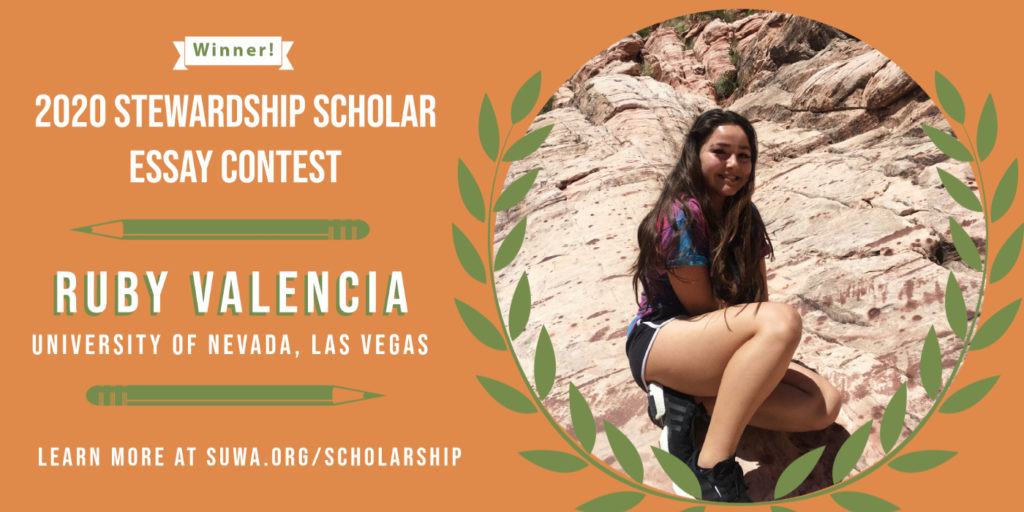Recognizing that people of color have historically been left out of the U.S. public land conservation movement, SUWA is committed to raising up diverse voices across the Intermountain West. Our Stewardship Scholar Essay Contest seeks to elevate new and essential voices through personal narratives pertinent to the broader conversation around public lands and their protection.
Please join us in celebrating the winners of our 2020 Stewardship Scholar Essay Contest. We are publishing each of the three winning essays every Wednesday through the end of February. Our second winner is Ruby Valencia.
Learning about Trust in Grapevine Canyon
by Ruby Valencia
As a born and raised Nevadan, I love the Southwest and its unique desert landscapes. At the age of 15 my school took us on a Mojave Desert field trip to look at Native American petroglyphs in a place called Grapevine Canyon. They have come to mean a lot to me.
It was a casual Friday afternoon and I could tell that everyone was excited because most of us had never been into the desert. It remains funny to me that I did not visit the desert until I was 15, especially because I had passed through this landscape many times traveling in and out of state. My Latinx parents have experiences of trauma in the natural desert so it’s not a place we visited for relaxation. The desert was a place of suffering for them while it remained a source of boredom for me. I didn’t think much of the trip because I wasn’t interested in standing outside in the scorching sun, risking sunburn and bug bites.
On our way there, I leaned on the windows and stared at the repetitive brown and green bushes next to the highway, thinking about how bleak this desert seemed. There was little variation between plant species, so my 15-year-old self quickly became bored. I’m proud to say that I’ve grown since then and I now realize how important this trip was for me. I now see the beauty in plants that have adapted to the extreme heat to survive these conditions.
Once we arrived, we wandered around the desert. Some of us prodded at the bushes, others climbed small hills. As the teachers rounded us up to head to the petroglyphs, I was sweating in the extreme heat and complaining internally. My expectations were dismal. I had anticipated that these petroglyphs would be too old and faded to be able to see anything. I was already disappointed without having seen them. Then, a staircase leading to the sandstone wall was in sight, which confused me. What kind of stone carving needed stairs? Apparently, the kind that are way high up on the wall. All of a sudden, I didn’t mind the sunshine, the heat, or the bugs. All I could think about were the petroglyphs before me. Students were lined up taking pictures and I couldn’t wait to see them up close. Once I got as close as I could to the petroglyphs, I felt something shift.
There is one reason I have such clear memory about this field trip: the deep feeling of peace that washed through me when I looked at the petroglyphs. That feeling has to do with the magnitude of time. These people, with their different customs and languages, knew the importance of transmitting their culture. They understood wanting to communicate their experiences to be heard.
I felt connected to these petroglyphs and understood something much deeper than their interesting appearance. Although I did not entirely understand what these images were conveying, I knew that it meant something important for them. It was important enough to be carved into stone.
I trusted this bedrock, just as the families living here hundreds of years ago had trust in it. Despite wind, water, sun, and animal, this rock wall still stands proud. In awe of the scale of the place and time, I learned to trust that this desert has a lot more to offer than the dry landscape. People before me spent time here, walked the earth that I walked on, creatively expressed themselves; I was but another person that did the same. It made me realize that human history is circular—we walk the same roads, feel the same feelings, and connect in shared ways.
I still visit Grapevine Canyon from time to time, but only when I’m feeling conflicted. Seeing the petroglyphs puts my tribulations into perspective. I have a relationship of trust with these petroglyphs—they allow me to center myself. I’ll stare at the images for a couple minutes and eventually, I find myself feeling at peace. It encourages me to think about the broader aspects of life and change my outlook when I stray too far. The ability to feel peace in this way keeps me grounded in a way that nothing else does.
I want to do everything in my power to protect these petroglyphs. Future generations of children deserve to make the same connection to this wild place that I did. Recently, I interned with the Nevada Conservation League to advocate for the protection of natural landscapes. Finding people that feel the same way about our land has given me hope about our climate crisis. In a world full of companies determined to destroy the planet, there remain people like us who refuse to give up. I have felt extremely validated and comforted to know that people like myself are environmental activists in this crazy, complicated world.
I am eternally grateful that Lake Mead is a protected landscape. Otherwise, would I or anybody else have been able to witness these ancient petroglyphs? Public lands should be protected for the people. I encourage more BIPOC to take time out of their lives to connect with the environment around them. You never know how much of an impact it’ll make on you.
Here are some of the pictures I took on the trip. May they inspire you as well.
 |
 |

I’m Ruby, a first-generation Latina at UNLV studying political science! I’m Vegas born & raised and I love exploring Nevada’s beautiful deserts in my free time! I’m an avid environmental advocate, interning at the Nevada Conservation League where I help spread our message: to maintain and enhance the natural character of Nevada and the quality of life for Nevadans through effective advocacy, the election of pro-conservation candidates and building collaboration. I believe in stopping climate change, protecting public lands, and environmental justice. Join your local conservation community and let’s make change happen!


